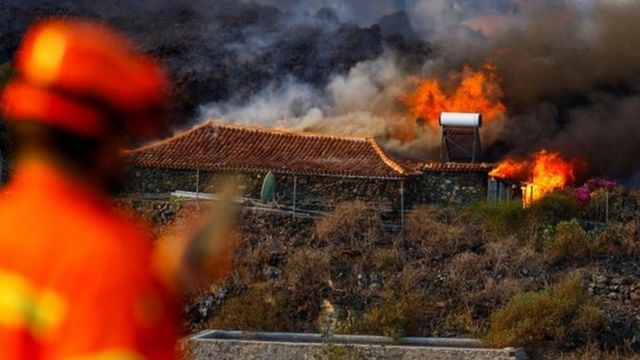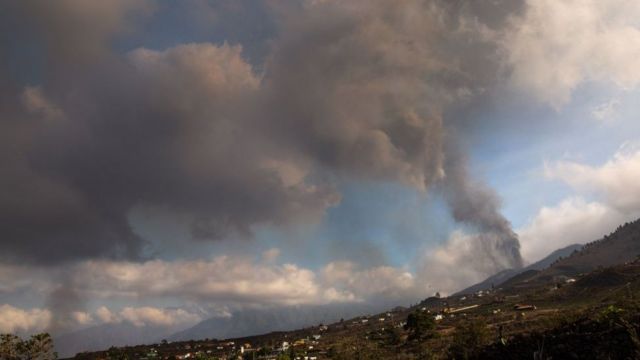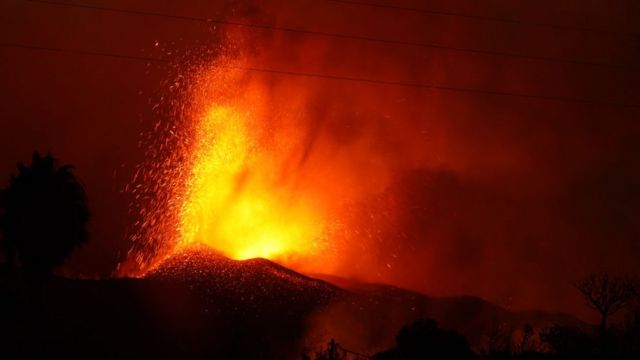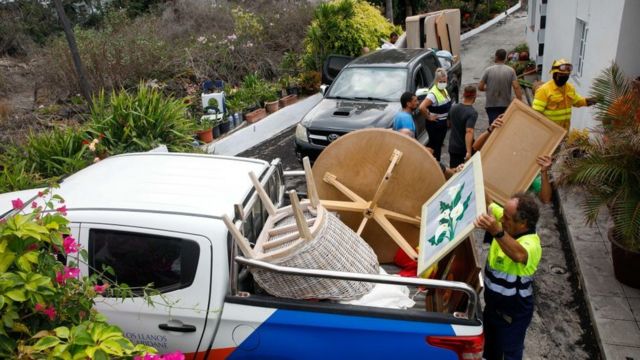What happens after a volcano erupts
House being destroyed by fire in La Palma
Whether out of scientific curiosity or because Brazil is lucky not to have active volcanoes, there are many doubts about what happens after an eruption.
In the popular imagination is that idea, learned at school, that soil of volcanic origin is more fertile. On the other hand, scenes of lava destroying everything, such as what we are seeing now in La Palma, in the Canary Islands, a Spanish territory on the northwest coast of Africa, make the power of this natural tragedy clear.
The first point to be analyzed is how long an eruption takes. "There are many variables, and the main one is to know how much magma is under the volcano, as it is this magma that fuels the eruption. It is stored in large underground pockets", explains geologist and volcanologist Carla Barreto, professor at the Federal University of Pernambuco (UFPE) — she coordinates the Instagram profile @vulcoeseviagens, whose posts are made together with her students.
In addition to the amount of magma, for an eruption to sustain itself, the passage to the lava exit must be left open. Or, as the researcher José Manuel Pacheco, director of the Institute for Research in Volcanology and Risk Assessment at the University of the Azores, in Portugal, explains, it is necessary "to preserve the volcano's feeding syste"Usually it does not influence, but there is an impact on the image of the shape of the volcano, that is, if it is conical, symmetrical, it causes a type of eruption; if it is a crack in the ground, the way in which the magma is expelled is different", he comments Barreto. She makes an analogy: When the rash starts, it's like a soda bottle being opened. "It causes a small explosion, and then the lava comes out", says the researcher.
"It's very difficult to say that [how long an eruption lasts]. Some stay for years, decades, hundreds of years, even two millennia…", comments geologist, astronomer and volcanologist Rosaly Lopes-Gautier, a scientist at NASA, the space agency American.
"In the case of the Canary Islands, chances are it won't be an active eruption for very long. It should last a matter of weeks, maybe months. Not years." She explains that to estimate this you need to look at "past eruptions" and compare characteristics.
That's what researcher Ben Ireland does, a volcanologist from the University of Bristol, England, and author of the profile @BensVolcanology on Twitter. To estimate the duration of the current eruption, he goes back to 1971.
“The last eruption in La Palma lasted 20 days. However, the current eruption already looks like it will be much larger than the previous one and therefore it should last longer. Typically, this style of eruption drags on, on a time scale , for weeks to months," he points out.
The volcanologist Pacheco nails something similar. "Most eruptions on the planet's surface last between one and six months. In the case of La Palma, the last eruptions lasted between three weeks and three months. In this case, similar behavior is to be expected," he says.
There are other nuances that need to be noted, as geologist Hugo Cássio Rocha, a professor at Mackenzie Presbyterian University, points out. "It is not a simple task to predict the eruption of a volcano far in advance, nor how long it will last. In general, this is done by analyzing the increase in frequency of seismic activity, the tremors. As they become more frequent, they indicate an increase in depth movement and pressures and magma movements," he says.
"It also depends on the composition of the magma", he adds. This is because magmas that are more acidic or granitic, that is, with a higher silicon content, tend to behave in such a way that events are faster and more violent — because the lava flows less. "On the other hand, basaltic magma volcanoes have the most fluid lava and it flows more easily. They are typical of the ocean floor and less violent, the eruption tends to be longer", points out Rocha.
The eruption could last for several months, officials said.
devastated land
But the images are of destruction in the Canary Islands. Homes were razed and thousands of inhabitants had to be evacuated. And such rivers of lava — which flow at temperatures in the region of 1,000 degrees — are advancing everywhere.
"When an eruption occurs in an already inhabited region, it is important to start by saying that the lavas will always have a tendency to go to the lowest places. They move as if following the flow of a river", explains volcanologist Barreto. And what is in the way, there is no way, ends up destroyed. "The lava invades the houses, burns the vegetation, destroys everything they have", enumerates the specialist.
"After the eruption, the region affected by the lava is like rock, like the 'lunar' environment. All the vegetation is burned, the structures destroyed", says Professor Rocha. "In the short term, the site is, yes, unusable. Over time, the rock [of volcanic formation], which is very porous, weathers, 'rots' and turns into soil. The time this occurs depends on the temperature environment and local rainfall."
"The area covered by the lava is unusable for agriculture or livestock, as there is no soil. It will take a long time for a new soil to be developed over the lava", points out Pacheco. He explains that, for the return of human occupation, everything depends on the thickness of the lava. "In the case of thick lavas like those from the eruption of the volcano in La Palma, which are 10 to 12 meters high, it will be very difficult to rebuild on top of them," he adds.
There would be stability problems in buildings, soil functions and even the connection to infrastructure such as water, electricity and sewage - enumerates the specialist. "However, it is possible to rebuild infrastructures such as the road network, as soon as the drain is already cold enough to allow intervention", he says.
Volcanologist Ireland points out that this cooling could "take months if the flows are intense". "Many times, when the eruption ends, people have no way to go back to their homes. They have been burned, razed to the ground. They have nowhere to go back," adds Barreto.
In these cases, it is more common for new settlements to be built elsewhere, given the difficulties of reoccupying the same space. "The soil [bathed by lava] is completely flattened and it takes a long time for new houses to be built there", points out Barreto. "The relief is all irregular and flattening is not easy, as it is rock."
The eruption of the Cumbre Vieja volcano has already destroyed hundreds of homes
Scratchs
But in addition to these inconveniences, say structural, there are other factors that make it difficult for the population to return to a region affected by a volcanic eruption. Mainly because the area is filled with toxic gases.
"There are tons of gases expelled by the volcano, including carbon dioxide and sulfur dioxide", explains Barreto. "In amounts above the acceptable limit in the atmosphere, they become harmful to people in these regions, causing physical and mental effects." The researcher says that these gases also contaminate the vegetation and, through the food chain, the animals that eat these plants. According to her, this high concentration of gases can last for years.
Lopes-Gautier adds that there is another risk factor: often, even if the volcano has stopped spewing lava, it continues to release gases. And this needs to be monitored, before a safe reoccupation of the region. Once this emission of gases ceases, they tend to dissipate, mainly due to the action of rain.
It is also necessary to wait for the ashes to be cleaned. "The finest particles may remain suspended in the air", recalls Pacheco. "They are irritating to the eyes and mucous membranes of the respiratory system and, if small enough, they can be breathed into the bronchi or alveoli in the lungs, where they can trigger health problems."
But the biggest danger is that there will be a new eruption. Therefore, a return permit from the inhabitants needs to be given after careful analysis. "Before the population returns, it is necessary to be sure that the volcano is really no longer active", emphasizes Lopes-Gautier. "It takes a lot of monitoring of the seismic activity to see if he's not just taking a nap and is going to start [pushing lava] again."
Earth tremors are also not uncommon in the months following volcanic activity. And this needs to be monitored by researchers and civil defense agencies.
"The main risk is another eruption," agrees Ireland. But he himself remembers that although the eruptions "are very destructive", they end up being "quickly forgotten by the population". "Many houses around the affected area are usually built years after the eruption." And this is what happened in the Canary Islands themselves, on other occasions.
Barreto says that, in regions where recent volcanic eruptions have occurred, efforts have been made to avoid new houses in lower relief regions, precisely so that populations are protected from future lava flows.
About 6,000 people had to leave their homes because of the eruption
Fertility
A soil of volcanic origin is usually very fertile. This is because the expelled material ends up bringing a rich wealth of mineral salts, in a process of "natural replenishment of soil nutrients", as Professor Barreto points out.
But if the volcanoes' positive side effect can be a result of the ash and small particles that spread even in regions that have not been covered by lava, the transformation of rocks resulting from the drying of lava into fertile soil is a process that can take a long time.
It is a degradation that varies from case to case. "Soils in volcanic regions are rich in minerals and therefore can be very fertile," comments Ireland. "It takes thousands of years for lava flows to erode and form a thin soil. For ash, this process is much faster."
"The conversion rate of the soil is very variable and depends on the climate, the composition of the ash and the thickness. For example, a very thin layer of ash on an existing soil [without lava cover] can become reconstructed soil in a matter of years", exemplifies the researcher.
This fertility, however, is the main reason why many human populations are living in regions where in the past there was volcanic activity.
"The important chemical elements for plants, nitrogen, phosphorus, potassium, calcium, sodium, among others, are very soluble and are washed away by rainwater. The volcano renews their stock in the soil, bringing them from the depths", contextualizes Professor Rocha. "Examples are the large olive and pistachio productions in Sicily [in Italy] and the explosion and renewal of life that take place on oceanic Pacific islands [of volcanic origin] which, shortly after volcanic activity, recover quickly and exuberantly. "m, so that the magma continues to have access to the surface".






No comments:
Post a Comment